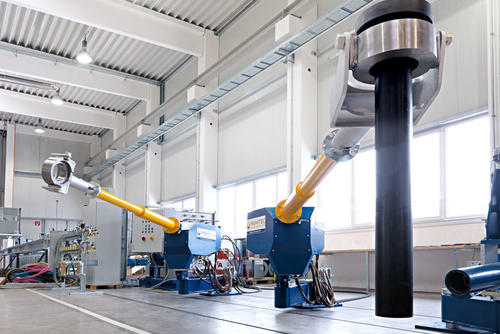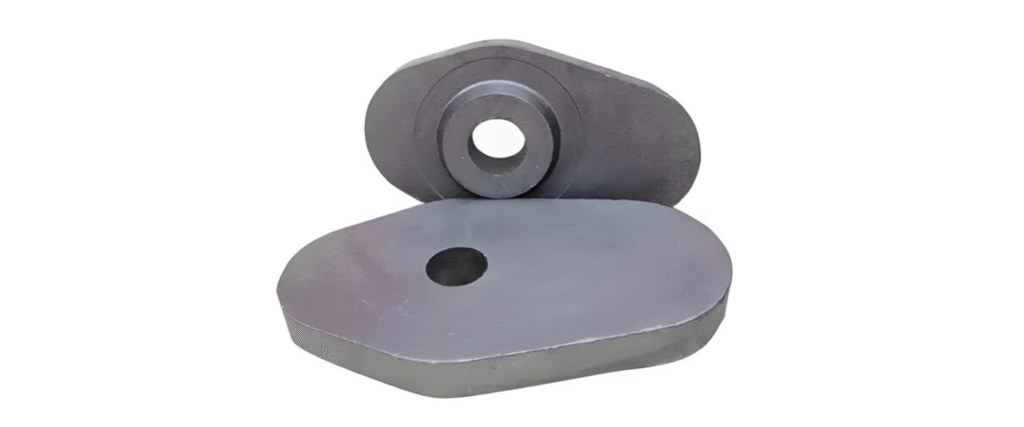In the continuous casting process, one of the key operations is the controlled transfer of molten steel from the ladle to the tundish. To maintain steel quality and process stability, a ladle shroud is used to prevent reoxidation and splashing. However, accurate alignment between the ladle shroud and the tundish inlet is critical. For this purpose, a ladle shroud manipulator is used. It provides safe, stable, and precise control of the shroud during the entire casting process.
This article explains what a ladle shroud is, describes the function and use of the ladle shroud manipulator, and discusses the main problems in the control process during continuous casting.

1. What Is a Ladle Shroud and Its Function
A ladle shroud is a high-temperature refractory tube that connects the ladle nozzle to the tundish inlet during the continuous casting process. Its main purpose is to create a closed and protected channel for molten steel flow, ensuring steel cleanliness and reducing oxidation.
Main Functions of the Ladle Shroud
- Prevent Reoxidation of Molten Steel: The ladle shroud isolates molten steel from air, preventing oxygen from reacting with the metal and forming inclusions.
- Reduce Heat Loss: It minimizes temperature drop by preventing direct contact between hot steel and the surrounding air.
- Prevent Splashing and Turbulence: The closed channel ensures smooth flow and reduces the risk of contamination in the tundish.
- Improve Casting Efficiency: Stable steel flow allows uniform solidification, fewer defects, and better overall casting performance.
Because of these benefits, the ladle shroud is a vital component in modern clean steel production.
2. What Is a Ladle Shroud Manipulator and Its Function
A ladle shroud manipulator is a mechanical or electro-hydraulic device designed to hold, position, and control the ladle shroud during casting. It ensures precise alignment between the ladle nozzle and the tundish inlet, maintaining a secure connection throughout the operation.
Functions of the Ladle Shroud Manipulator
- Accurate Alignment: Keeps the shroud centered with the ladle slide gate and tundish nozzle to avoid leakage or air aspiration.
- Safe Operation: Allows remote control to prevent workers from exposure to high temperatures and molten steel splashes.
- Stable Control: Maintains steady positioning during tundish or ladle movement.
- Flexible Movement: Enables quick lifting or swinging of the shroud during ladle change or tundish replacement.
- Automatic Adjustment: Advanced manipulators use sensors to automatically correct alignment and maintain proper pressure.
The manipulator plays an essential role in improving safety, accuracy, and automation in steel plant operations.
3. How to Use the Ladle Shroud Manipulator
Correct operation of the manipulator ensures safe, efficient, and stable molten steel transfer. The process involves several key steps.
Step 1: Pre-Operation Inspection
- Inspect the ladle shroud for cracks or surface damage.
- Check the manipulator’s clamps, arms, and joints for wear or looseness.
- Ensure hydraulic and pneumatic systems are functioning properly.
- Test control panels and motion sensors for accuracy and response.
- Confirm the correct position of the ladle turret and tundish car.
Step 2: Mounting the Ladle Shroud
- Open the manipulator’s clamping device.
- Insert the ladle shroud and align it with the reference marks.
- Tighten the clamp securely without damaging the refractory surface.
- Apply sealing paste or gasket if required for airtight contact.
Step 3: Aligning with Ladle and Tundish Nozzles
Move the manipulator arm slowly to position the shroud between the ladle nozzle and tundish inlet. Adjust vertically and horizontally until the centerlines match perfectly. Verify cleanliness and tight contact at both ends before casting begins.
Step 4: Operation During Casting
- Maintain constant pressure for a tight seal.
- Monitor position and vibration through the operator panel or camera system.
- Ensure the manipulator compensates for any tundish car movement.
- Watch for signs of air aspiration, splashing, or misalignment.
Step 5: End of Casting and Disengagement
- Close the ladle slide gate to stop molten steel flow.
- Retract the manipulator arm carefully.
- Release the clamp and remove the used ladle shroud.
- Cool and dispose of the used shroud properly.
- Clean, inspect, and maintain the manipulator for the next operation.
4. Main Problems in the Control Process
Although the ladle shroud manipulator greatly improves safety and efficiency, several control challenges can occur during operation.
1. Misalignment Between Nozzles
Small alignment errors between the ladle nozzle and tundish inlet can cause steel leakage or air aspiration.
Solution: Regularly calibrate positioning sensors and verify alignment before each casting cycle.
2. Hydraulic or Pneumatic Failure
Loss of pressure may lead to sudden or unsafe movements of the manipulator arm.
Solution: Maintain hydraulic systems and install safety locks or backup pressure circuits.
3. Vibration During Casting
Vibration from the tundish car or ladle turret affects the shroud’s stability and sealing performance.
Solution: Add vibration dampers and ensure a rigid manipulator mounting base.
4. Overheating and Thermal Expansion
High radiant heat can cause parts to expand, reducing control precision.
Solution: Use heat shields and schedule periodic cooling intervals.
5. Sensor and Control Delay
In automated systems, signal delays can lead to poor response during high-speed adjustments.
Solution: Use fast-response servo systems and regularly update control software.
Conclusion
The ladle shroud manipulator is a crucial device for ensuring accurate, safe, and efficient molten steel transfer during continuous casting. By maintaining correct alignment, steady pressure, and reliable control, it enhances steel quality and reduces operational risks.
Understanding its structure, following correct usage steps, and solving common control problems are essential for maintaining continuous casting stability and achieving high-quality steel production.
SEO Keywords:
ladle shroud, ladle shroud manipulator, continuous casting, molten steel transfer, tundish nozzle, ladle nozzle, refractory tube, steel plant equipment, clean steel production, hydraulic manipulator


